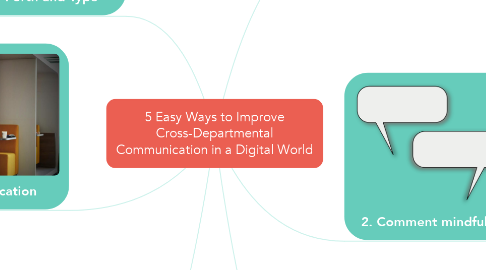
1. 4. Perform a needs analysis
1.1. When should you perform need analysis?
1.1.1. If you request something from another department
1.1.2. and what you receive back is not what you needed or expected
1.2. Ask the recipient what information they would like to receive
1.2.1. the next time you send them a task
1.3. turn that information into something actionable
1.3.1. like a checklist
1.4. You can also do this in many other forms
1.4.1. a Word document with bullet points would suffice
1.5. It’s never too early to do this
1.5.1. Chances are if you communicate with someone in another department once
1.5.2. you will communicate with them again
2. 5. Ask for clarification
2.1. if you are on the receiving end of poor communication
2.1.1. don’t be afraid to ask for clarification
2.2. When you’ve gone several rounds with someone
2.2.1. and still aren’t sure what they’re asking for
2.2.2. your frustration level is bound to rise
2.3. But at times like these
2.3.1. it’s important to remember that no one intentionally communicates poorly
2.4. Everyone is doing their best
2.4.1. and usually only sees things from their own perspective
2.5. My personal experience
2.5.1. the more questions I ask to clarify my own understanding
2.5.2. the more appreciative the other party is
2.5.3. And they are certainly happier with the end result
3. Go Forth and Type
3.1. These tips may not seem like they can move mountains
3.1.1. but subtle changes over time can truly make a difference
3.2. Just as we try to communicate mindfully in person
3.2.1. so we should strive to communicate mindfully across our ever-diversifying digital formats
4. Download "Benefits of Mind Mapping" pdf --->
5. 1. Write clear task descriptions
5.1. we assume that the tasks on our project board are only for our team
5.1.1. and we write them with exactly that audience in mind
5.2. But if you know ahead of time
5.2.1. that you will need support or input from another department
5.2.2. take the time to write the task description for an audience
5.2.3. who hasn’t attended every meeting leading up to the task or project creation
5.3. The user’s role
5.3.1. the task goal
5.3.2. the error
5.3.3. and solution
5.3.3.1. Must be clearly defined
5.3.4. Checklist item should have
5.3.4.1. in which order the tasks should be completed
5.3.4.2. and who the task is assigned to
5.3.4.2.1. even if they are from a different department
6. 2. Comment mindfully
6.1. make sure the comment is detailed enough
6.2. A clear task description looks like:-
6.2.1. “Please read the task description and let me know if you have any questions,”
6.2.2. The above comment should suffice
6.3. If you realise the task is unclear
6.3.1. write a detailed comment
6.3.2. write a quick comment with an offer to chat
6.3.3. or change the task description
7. 3. Attach a visual
7.1. “a picture is worth a thousand words,”
7.1.1. exists for a reason
7.2. if its possible to provide a visual representation
7.2.1. please do so
7.3. Oftentimes, seeing what is required
7.3.1. rather than just reading or hearing it
7.3.2. can drastically improve the outcome
